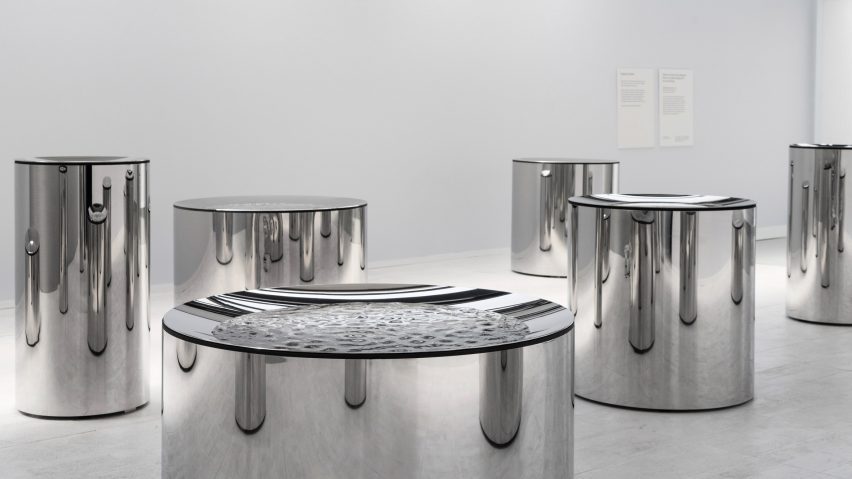Tech giant Google has created an installation with American artist Lachlan Turczan that explores the "hidden qualities of water" at Milan Design Week.
Called Shaped by Water, the installation is set inside a redeveloped industrial building in the city's centre and divided into three distinct spaces.
The first two contains newly commissioned artworks by Turczan, in which mirrored stainless steel basins filled with water are effectively used as giant speakers, vibrating at different frequencies to create hypnotic wave patterns.
"Sound becomes a tool that allows you to sculpt this pool of water into a dynamic shifting landscape," the artist told Dezeen.
The third and final room showcases different Google hardware products and illustrates how the design was informed by the unique performance characteristics of water, such as its surface tension.
"We wanted to give guests a first-of-its-kind experience that reveals the hidden qualities of water when acted upon by sound and light," said Google's vice president of hardware design Ivy Ross.
"Water is easily recognised in its various forms, yet it has distinct and unique qualities that are not always evident – qualities that we caught glimpses of during our design process."
Visitors enter the installation via a bright white room, filled with 11 of Turczan's reflective stainless steel basins, as part of a work called Sympathetic Resonance.
Internal transducers vibrate each basin at a different frequency based on the resonant frequency of that basin, which in turn creates distinctive wave patterns based on the size of the basin.
"For all intents and purposes, they are actually just large speakers," explained Turczan, who cut his teeth choreographing water displays such as the Fountains of Bellagio in Las Vegas before starting his art practice.
While the smaller vessels have higher frequencies and create faster, tighter wave patterns, some of the bigger vessels have such low frequencies they are below the human audible spectrum, creating more sluggish waves.
"You have these waves happening at such low oscillations, it's almost like stop motion," Turczan said. "For me, it's really exciting to think about it as a way of sifting time. It's making you feel like everything is moving slower."
Three of the smaller basins were also designed to respond to the proximity of the visitor, as assessed by several overhead cameras. The closer the spectator gets, the more intensely the basin vibrates and the more erratic the wave pattern becomes.
The second space, containing Turczan's artwork Wavespace, is reminiscent of a blacked-out theatre and allows visitors to take in not just a single tone but a whole piece of music via the ripples it creates in the basin.
Here, there are only two basins – each illuminated by a pendant light fitted with a custom optic lens for a shade. This helps to re-focus the light that is reflected and refracted by the water and projects it onto a circular overhead screen.
"I spent nearly a decade developing this set-up," Turczan said. "It's really similar to how early telescopes worked."
Each basin is encircled by a round sofa, inviting visitors to recline and look up at the screen above so they can watch the way the water moves in response to a 10-minute song, merging classical and electronic melodies.
Over the course of the song, the vibrating basin creates a range of different hypnotic visuals, sometimes reminiscent of a kaleidoscope and other times evoking a timelapse of tiny organisms seen through a microscope.
"It's like looking into a fire or cloud gazing," Turczan said. "People's imaginations will get triggered."
"I'm working with a couple of hotels to build a permanent architectural space around this," he added. "Since it's so musical, I also like the idea of treating it kind of like a concert venue, where the audience is in the centre and the musicians play around you."
The installation's third and final space showcases different Google hardware products including last year's Pixel Watch.
The smartwatch is displayed next to what appears to be one of its rounded glass displays but in reality, is simply a flat disk topped with a puddle of water that holds its smoothly curved shape only due to the surface tension of the water.
"We actually did these live water experiments where we would drop water onto a disk," said Google industrial designer Jessica Choi. "And we would look at the tension the water droplets create and then carry them over directly to our products."
This is the third time that Google has exhibited at Milan design week and the first time the company has returned since the coronavirus pandemic. The brand made its Milan debut in 2018 with an exhibition on how electronic devices can become more tactile, created in collaboration with trend forecaster Li Edelkoort.
The following year, the brand partnered with scientists for an installation exploring how different aesthetic experiences can impact our health and wellbeing.
Shaped by Water is on display at Garage 21 from 18 to 23 April 2023 as part of Milan design week. See our Milan design week 2023 guide on Dezeen Events Guide for information about the many other exhibitions, installations and talks taking place throughout the week.

